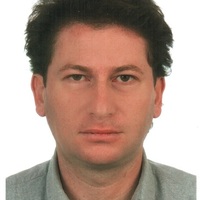- Eastern Macedonia and Thrace Institute of Technology
Agios Loukas - Kavala
Greece (GR65404) - +302510462183
- Add Social Profiles(Facebook, Twitter, etc.)
•
Change of DNA sequence that fuels evolution is, to a certain extent, a deterministic process because mutagenesis does not occur in an absolutely random manner. So far, it has not been possible to decipher the rules that govern DNA... more
Change of DNA sequence that fuels evolution is, to a certain extent, a deterministic process because mutagenesis does not occur in an absolutely random manner. So far, it has not been possible to decipher the rules that govern DNA sequence evolution due to the extreme complexity of the entire process. In our attempt to approach this issue we focus solely on the mechanisms of mutagenesis and deliberately disregard the role of natural selection. Hence, in this analysis, evolution refers to the accumulation of genetic alterations that originate from mutations and are transmitted through generations without being subjected to natural selection. We have developed a software tool that allows modelling of a DNA sequence as a one-dimensional cellular automaton (CA) with four states per cell which correspond to the four DNA bases, i.e. A, C, T and G. The four states are represented by numbers of the quaternary number system. Moreover, we have developed genetic algorithms (GAs) in order to determine the rules of CA evolution that simulate the DNA evolution process. Linear evolution rules were considered and square matrices were used to represent them. If DNA sequences of different evolution steps are available, our approach allows the determination of the underlying evolution rule(s). Conversely, once the evolution rules are deciphered, our tool may reconstruct the DNA sequence in any previous evolution step for which the exact sequence information was unknown. The developed tool may be used to test various parameters that could influence evolution. We describe a paradigm relying on the assumption that mutagenesis is governed by a near-neighbour-dependent mechanism. Based on the satisfactory performance of our system in the deliberately simplified example, we propose that our approach could offer a starting point for future attempts to understand the mechanisms that govern evolution. The developed software is open-source and has a user-friendly graphical input interface.
Publication Date: 2008
Publication Name: Biosystems
Research Interests:
•
Publication Date: 2008
•
by Charilaos Mizas and V. Mardiris
Cellular automata are introduced as a model for DNA structure, function and evolution. DNA is modeled as a one-dimensional cellular automaton with four states per cell. These states are the four DNA bases A, C, T and G. The four states... more
Cellular automata are introduced as a model for DNA structure, function and evolution. DNA is modeled as a one-dimensional cellular automaton with four states per cell. These states are the four DNA bases A, C, T and G. The four states are represented by numbers of the quaternary number system. Linear evolution rules, represented by square matrices, are considered. Based on this model a simulator of DNA evolution is developed and simulation results are presented. This simulator has a user-friendly input interface and can be used for the study of DNA evolution.
Publication Date: 2003
Publication Name: Computers in Biology and Medicine
Research Interests:
•
Publication Date: 2000
Publication Name: 2000 IEEE International Symposium on Circuits and Systems. Emerging Technologies for the 21st Century. Proceedings (IEEE Cat No.00CH36353)
Research Interests:
•
Publication Date: 2008
•
The increasing complexity of computer networks calls for the development of new models for their simulation. Cellular automata (CAs) are a well-known and successful model for complex systems. This paper presents a system for modeling and... more
The increasing complexity of computer networks calls for the development of new models for their simulation. Cellular automata (CAs) are a well-known and successful model for complex systems. This paper presents a system for modeling and simulation of computer networks based on CAs. More specifically, a 2D NaSch CA computer network model has been developed, and several networks were simulated.
Publication Date: 2000
Publication Name: IEEE Transactions on Systems, Man, and Cybernetics, Part C (Applications and Reviews)
Research Interests: Engineering, Modeling and Simulation, Cellular Automata, Complex System, Computer Network, and 11 moreWireless Network, Hardware Design, VERY LARGE SCALE INTEGRATED CIRCUITS, System Reliability, Ad hoc network, Design Automation, Circuit Design, Design and Development, Language Model, Hardware Implementation of Algorithms, and Shortest Path
•
Publication Date: 2008
•
Quantum–Dot Cellular Automata Design for Median Filtering and Mathematical Morphology Operations on Binary Imagesmore
by V. Chatzis and V. Mardiris
Publication Date: 2012
•
Publication Date: 2013
Publication Name: 2013 IEEE International Conference on Imaging Systems and Techniques (IST)
•
•
•
by V. Mardiris and V. Chatzis
Publication Date: 2014
Publication Name: Emergence, Complexity and Computation
•
Cellular automata are introduced as a model for DNA structure, function and evolution. DNA is modeled as a one-dimensional cellular automaton with four states per cell. These states are the four DNA bases A, C, T and G. The four states... more
Cellular automata are introduced as a model for DNA structure, function and evolution. DNA is modeled as a one-dimensional cellular automaton with four states per cell. These states are the four DNA bases A, C, T and G. The four states are represented by numbers of the quaternary number system. Linear evolution rules, represented by square matrices, are considered. Based on this model a simulator of DNA evolution is developed and simulation results are presented. This simulator has a user-friendly input interface and can be used for the study of DNA evolution.
Publication Date: 2003
Publication Name: Computers in Biology and Medicine
Research Interests:
•
Publication Date: 2004
Research Interests:
•
Publication Date: 2004
Research Interests:
•
